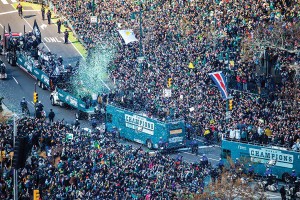Deconstructing Bart Blatstein
THERE IS CONSIDERABLE DOUBT as to whether Blatstein’s Rooftop Village dream will get off the ground. In Harrisburg, efforts to take away Philadelphia’s second casino license rage on. And if another casino does happen, potential owner-operators will compete in some serious politicking.
Till then, speculation will abound—about the fate of casinos in Philadelphia and Blatstein. “In addition to whatever concerns I have over whether or not a casino near City Hall is good for the city, I worry that this is a step back for Bart,” says Inga Saffron. “He’s worked very hard in North Philadelphia and Northern Liberties and done a great job of establishing himself as a brand. As someone who understands how to build a youthful and vibrant community. A casino is none of that.”
Blatstein’s response is coldly pragmatic. “Look,” he says, “the casino finances the rest. I need a 24-hour, seven-day-a-week venue to leverage the entire project. Without it, this can’t happen.”
He also insists he can construct a casino in keeping with his more recently developed New Urbanist principles.
But for now, with so much still uncertain about the project, Blatstein’s latest plan works best as a metaphor for the man and the builder: A rooftop village with a retractable glass roof, which creates and enforces a sense of mystery? A $600 million development that combines a ruthlessly practical casino with the blissfully zany dream of a rooftop village? In these terms, Blatstein’s new plan for North Broad Street seems to stamp Bart himself on Philadelphia—the good Bart and the bad, the practical and the visionary, all in one place.
Several days after Bart Blatstein informed me that I was over his barrier, he invited me to watch a Sixers game with him and his 27-year-old son, Ryan. For an hour or two, we relaxed in front of a big flat-screen television, as Blatstein gently chided his son, the bigger fan, every time something went slightly wrong for the home team. “Ry, Ry,” he’d say whenever the opposing team scored a basket. “How’d that happen?”
Ryan, who’s a hulking six-foot-seven, works for his father as an assistant project manager. (Blatstein’s daughter, Jenna, 26, designs lingerie for her own company in New York.) At halftime he ran out for drinks, yogurt and granola. Blatstein handed over his own iPad, so I could see what passages he’d highlighted in Ed Glaeser’s Triumph of the City—a manifesto of New Urbanism. And when the Sixers won, Blatstein announced he was headed to the gym.
The mystery of what he does for exercise, sort of solved.
The comparative normalcy of this tableau put me in mind of something deputy mayor for planning and economic development Allan Greenberger told me: “In the years when a developer is working, personalities seem very important. But in time, all that is forgotten. And what we have left are the buildings.”
After spending weeks chasing Blatstein, trying to get him to open up, I realized the most telling moment occurred on day one.
After Blatstein had given a press conference in the lobby of the state office building, he took me upstairs, to the roof. From 18 stories up, with no surrounding wall, Philadelphia rolled out before us. And Blatstein leaned gently against my shoulder, orienting me and pointing me through the major stops in his career. Far to the south, somewhere in the haze of development along Columbus Boulevard, Blatstein’s first, aesthetically faceless retail and theater boxes squatted.
We turned 180 degrees: To the north, up Broad Street, lay the shiny new apartment buildings and the gleaming silver retail, restaurant and theater hub he built at Temple. Finally, almost directly east, Northern Liberties sprawled, with the vari-tinted windows of the Piazza signaling the position of what is, to date, his grandest creation.
Blatstein had been up here several times before, trying to figure out what he might do with the roof itself—perhaps an incredible apartment?—and felt comfortable enough with the height to stride out to the edge. For a moment, when he turned back to me, his long, lanky frame was silhouetted and fanning out over the city—his Temple creations seemingly hanging just over his left shoulder, the Piazza resplendent to his right. It was the defining shot of Blatstein: a man we could endeavor in frustration to understand, when all we really need to know, for history’s sake, is written on the landscape.


